Uranyl carbonates are one of the largest groups of secondary uranium(VI)-bearing natural phases being represented by 40 minerals approved by the International Mineralogical Association, overtaken only by uranyl phosphates and uranyl sulfates. Uranyl carbonate phases form during the direct alteration of primary U ores on contact with groundwaters enriched by CO2, thus playing an important role in the release of U to the environment. The presence of uranyl carbonate phases has also been detected on the surface of “lavas” that were formed during the Chernobyl accident.
- uranyl
- carbonate
- mineral
- crystal structure
- topology
- structural complexity
1. Introduction of Uranyl Carbonate Minerals
Uranyl carbonate phases play a very important role in all processes related to the nuclear fuel cycle. under the influence of groundwaters enriched with CO2, which can be derived from the dissolution of host carbonate rocks or from the atmosphere [1][2][3][4][5]. In dissolved form, uranyl carbonates can play an important role in U release to the environment. And of course, it should not be forgotten that uranyl-carbonate mineralization has been described among the alteration products of the “lavas” that were formed during the accident at the fourth reactor of the Chernobyl nuclear power plant in 1986 [6][7].
There are 40 uranyl carbonate mineral species approved by the International Mineralogical Association as of 1 November 2020, thus making this group one of the most representative among secondary uranium minerals, coming third only after phosphates and sulfates [8][9]. Despite a fairly large number of known compounds, the structural diversity is not as great as one might expect. It is also of interest that about a quarter of approved minerals still have their crystal structures undetermined. The amount of synthetic structurally characterized uranyl carbonates is inferior to natural phases but can give an idea of the crystallization conditions present in the environment.
Current work is devoted to reviewing the topological diversity and growth conditions of natural uranyl carbonates and their synthetic analogs. Information-based complexity measures have been performed to determine contributions of various substructural building blocks and particular topological types into the complexity of the whole structure, which is related to the stability of a crystalline compound.
2. Synthetic Uranyl Carbonates
3. Topological Analysis
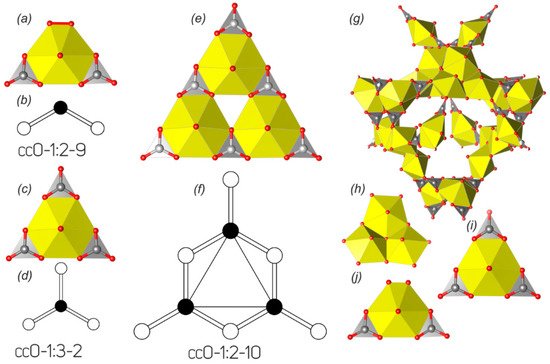
| No. | Chemical Formula | Mineral Name | Sp.Gr. | a, Å/ α, ° |
b, Å/ β, ° |
c, Å/ γ, ° |
Ref. |
|---|---|---|---|---|---|---|---|
| Finite Clusters | |||||||
| cc0-1:2-9 | |||||||
| 1 | K4[(UO2(CO3)2(O2)](H2O) | P21/n | 6.9670(14)/90 | 9.2158(18)/91.511(3) | 18.052(4)/90 | [14] | |
| 2 | K4[(UO2(CO3)2(O2)](H2O)2.5 | P21/n | 6.9077(14)/90 | 9.2332(18)/91.310(4) | 21.809(4)/90 | [15] | |
| 3 | (CN3H6)4[UO2(CO3)2(O2)]·H2O | Pca21 | 15.883(1)/90 | 8.788(2)/90 | 16.155(1)/90 | [24] | |
| cc0-1:3-2 | |||||||
| 4 | Na4(UO2)(CO3)3 | Čejkaite | Cc | 9.2919(8)/90 | 16.0991(11)/91.404(5) | 6.4436(3)/90 | [28] |
| 4a | Na4(UO2)(CO3)3 | P-3c | 9.3417/90 | 9.3417/90 | 12.824/120 | [22][16][12] | |
| 4b | Na4(UO2)(CO3)3 | Cejkaite old model |
P-1 | 9.291(2)/90.73(2) | 9.292(2)/90.82(2) | 12.895(2)/120.00(1) | [29] |
| 5 | K3Na(UO2)(CO3)3 | P-62c | 9.29(2)/90 | 9.29(2)/90 | 8.26(2)/120 | [30] | |
| 6 | K3Na(UO2)(CO3)3(H2O) | Grimselite | P-62c | 9.2507(1)/90 | 9.2507(1)/90 | 8.1788(1)/120 | [23][31][32][33] |
| 6a | Rb6Na2((UO2)(CO3)3)2(H2O) | Rb analogue of Grimselite |
P-62c | 9.4316(7)/90 | 9.4316(7)/90 | 8.3595(8)/120 | [34] |
| 7 | K4(UO2)(CO3)3 | Agricolaite | C2/c | 10.2380(2)/90 | 9.1930(2)/95.108(2) | 12.2110(3)/90 | [35] |
| 7a | K4UO2(CO3)3 | C2/c | 10.247(3)/90 | 9.202(2)/95.11(2) | 12.226(3)/90 | [21] | |
| 7b | K4(UO2)(CO3)3 | C2/c | 10.240(7)/90 | 9.198(4)/95.12(4) | 12.222(12)/90 | [17] | |
| 58 | Rb4(UO2)(CO3)3 | C2/c | 10.778(5)/90 | 9.381(2)/94.42(3) | 12.509(3)/90 | [18] | |
| 8 | Cs4UO2(CO3)3(H2O)6 | P21/n | 11.1764(4)/90 | 9.5703(4)/ 96.451(2) | 18.5756(7)/90 | [36] | |
| 8a | Cs4(UO2(CO3)3)(H2O)6 | P21/n | 18.723(3)/90 | 9.647(2)/96.84(1) | 11.297(2)/90 | [37] | |
| 9 | Cs4(UO2(CO3)3) | C2/c | 11.5131(9)/90 | 9.6037(8)/93.767(2) | 12.9177(10)/90 | [38] | |
| 10 | (NH4)4(UO2(CO3)3) | C2/c | 10.679(4)/90 | 9.373(2)/96.43(2) | 12.850(3)/90 | [39] | |
| 11 | Tl4((UO2)(CO3)3) | C2/c | 10.684(2)/90 | 9.309(2)/94.95(2) | 12.726(3)/90 | [19] | |
| 12 | Mg2(UO2)(CO3)3(H2O)18 | Bayleyite | P21/a | 26.560(3)/90 | 15.256(2)/92.90(1) | 6.505(1)/90 | [40][41] |
| 13 | CaMg(UO2)(CO3)3(H2O)12 | Swartzite | P21/m | 11.080(2)/90 | 14.634(2)/99.43(1) | 6.439(1)/90 | [40][42][43] |
| 14 | Ca2(UO2)(CO3)3(H2O)11 | Liebigite | Bba2 | 16.699(3)/90 | 17.557(3)/90 | 13.697(3)/90 | [40][44][45][46] |
| 15 | Ca9(UO2)4(CO3)13·28H2O | Markeyite | Pmmn | 17.9688(13) | 18.4705(6) | 10.1136(4) | [47] |
| 16 | Ca8(UO2)4(CO3)12·21H2O | Pseudomarkeyite | P21/m | 17.531(3) | 18.555(3) | 9.130(3)/103.95(3) | [48] |
| 17 | Sr2UO2(CO3)3)(H2O)8 | P21/c | 11.379(2)/90 | 11.446(2)/93.40 (1) | 25.653(4)/90 | [49] | |
| 18 | Na6Mg(UO2)2(CO3)6·6H2O | Leószilárdite | C2/m | 11.6093(21)/90 | 6.7843(13)/91.378(3) | 15.1058(28)/90 | [50] |
| 19 | Na2Ca(UO2)(CO3)3(H2O)5.3 | Andersonite | R-3m | 17.8448(4)/90 | 17.8448(4)/90 | 23.6688(6)/120 | [23][40][44][51][52][53][54][55][56][57][58][59][60][61] |
| 20 | Na2Ca8(UO2)4(CO3)13·27H2O | Natromarkeyite | Pmmn | 17.8820(13) | 18.3030(4) | 10.2249(3) | [48] |
| 21 | Ca3Na1.5(H3O)0.5(UO2(C O3)3)2(H2O)8 | Pnnm | 18.150(3)/90 | 16.866(6)/90 | 18.436(3)/90 | [62] | |
| 22 | K2Ca(UO2)(CO3)3·6H2O | Braunerite | P21/c | 17.6725(12)/90 | 11.6065(5)/101.780(8) | 29.673(3)/90 | [63] |
| 23 | K2Ca3[(UO2)(CO3)3]2·8(H2O) | Linekite | Pnnm | 17.0069(5)/90 | 18.0273(5)/90 | 18.3374(5)/90 | [64] |
| 23a | K2Ca3((UO2(CO3)3)2(H2O)6 | Pnnm | 17.015(2)/90 | 18.048(2)/90 | 18.394(2)/90 | [65] | |
| 24 | SrMg(UO2)(CO3)3(H2O)12 | Swartzite-(Sr) | P21/m | 11.216(2)/90 | 14.739(2)/99.48(1) | 6.484(1)/90 | [40][42] |
| 25 | Na0.79Sr1.40 Mg0.17 (UO2(C O3)3)(H2O)4.66 |
Pa-3 | 20.290(3)/90 | 20.290(3)/90 | 20.290(3)/90 | [66] | |
| 26 | MgCa5Cu2(UO2)4(CO3)12 (H2O)33 |
Paddlewheelite | Pc | 22.052(4)/90 | 17.118(3)/90.474 (2) | 19.354(3)/90 | [67] |
| 27 | Na8[(UO2)(CO3)3](SO4)2·3H2O | Ježekite | P-62m | 9.0664(11)/90 | 9.0664(11)/90 | 6.9110(6)/120 | [68] |
| 28 | NaCa3(UO2)(CO3)3 (SO4)F(H2O)10 | Schröckingerite | P-1 | 9.634(1)/91.41(1) | 9.635(1)/92.33(1) | 14.391(2)/120.26(1) | [40][69][70][71][72] |
| 29 | MgCa4F2[UO2(CO3)3]2 (H2O)17.29 |
Albrechtschraufite | P-1 | 13.569(2)/115.82(1) | 13.419(2)/107.61(1) | 11.622(2)/92.84(1) | [73][74] |
| 30 | Ca5(UO2(CO3)3)2(NO3)2 (H2O)10 |
P21/n | 6.5729(9)/90 | 16.517(2)/90.494(3) | 15.195(2)/90 | [75] | |
| 31 | Ca6(UO2(CO3)3)2Cl4(H2O)19 | P4/mbm | 16.744(2)/90 | 16.744(2)/90 | 8.136(1)/90 | [75] | |
| 32 | Ca12(UO2(CO3)3)4Cl8(H2O)47 | Fd-3 | 27.489(3)/90 | 27.489(3)/90 | 27.489(3)/90 | [75] | |
| 33 | Nd2Ca[(UO2)(CO3)3](CO3)2 (H2O)10.5 |
Shabaite-(Nd) | P-1 | 8.3835(5)/90.058(3) | 9.2766(12)/89.945(4) | 31.7519(3)/90.331(4) | [76][77] |
| 34 | [C(NH2)3]4[UO2(CO3)3] | R3 | 12.3278(1)/90 | 12.3278(1)/90 | 11.4457(2)/120 | [78] | |
| 35 | (C4H12N)4[UO2(CO3)3]·8H2O | P21/n | 10.5377(18)/90 | 12.358(2)/99.343(4) | 28.533(5)/90 | [79] | |
| cc0-1:2-10 | |||||||
| 36 | [C(NH2)3]6[(UO2)3(CO3)6] (H2O)6.5 |
P-1 | 6.941(2)/95.63(2) | 14.488(2)/98.47(2) | 22.374 (2)/101.88(2) | [20] | |
| Nanoclusters | |||||||
| 37 | Mg8Ca8(UO2)24(CO3)30O4 (OH)12(H2O)138 |
Ewingite | I41/acd | 35.142(2)/90 | 35.142(2)/90 | 47.974(3)/90 | [80] |
| Layers | |||||||
| 544234 (β-U3O8) | |||||||
| 38 | CaU(UO2)2(CO3)O4(OH) (H2O)7 |
Wyartite | P212121 | 11.2706(8)/90 | 7.1055(5)/90 | 20.807(1)/90 | [81][82][83] |
| 38a | Ca(U(UO2)2(CO3)0.7O4(OH)1.6) (H2O)1.63 | Wyartite dehydrated |
Pmcn | 11.2610(6)/90 | 7.0870(4)/90 | 16.8359(10)/90 | [84] |
| 61524232 (phosphuranylite) | |||||||
| 39 | Ca(UO2)3(CO3)2O2(H2O)6 | Fontanite | P21/n | 6.968(3)/90 | 17.276(7)/90.064(6) | 15.377(6)/90 | [85][86] |
| 61524236 (roubaultite) | |||||||
| 40 | Cu2(UO2)3(CO3)2O2(OH)2 (H2O)4 |
Roubaultite | P-1 | 7.767(3)/92.16(4) | 6.924(3)/90.89(4) | 7.850(3)/93.48(4) | [87][88] |
| 6132-I (rutherfordine) | |||||||
| 41 | (UO2)(CO3) | Rutherfordine | Imm2 | 4.840(1)/90 | 9.273(2)/90 | 4.298(1)/90 | [23][89][13][90][91] |
| 42 | Ca(H2O)3[(UO2)3(CO3)3.6O0.2] | Sharpite | Cmcm | 4.9032(4) | 15.6489(11) | 22.0414(18) | [92] |
| 42a | Ca(UO2)6(CO3)5(OH)4·6H2O | Sharpite | Orth | 21.99(2) | 15.63(2) | 4.487(4) | [93][94] |
| 6132-II (widenmannite) | |||||||
| 43 | Pb2[(UO2)(CO3)2] | Widenmannite | Pmmn | 4.9350(7)/90 | 9.550(4)/90 | 8.871(1)/90 | [31][95][96][97] |
| Layers of Miscellaneous Topology | |||||||
| 44 | Y2(UO2)4(CO3)3O4·14H2O | Kamotoite-(Y) | P21/n | 12.3525(5) | 12.9432 (5)/99.857(3) | 19.4409(7) | [98][99] |
| 45 | [(Y4.22Nd3.78)(H2O)25(UO2)16O8 (OH)8(CO3)16](H2O)14 |
Bijvoetite-(Y) | B21 | 21.234(3)/90 | 12.958(2)/90.00(2) | 44.911(7)/90 | [100][101] |
| 46 | Ca(UO2)(CO3)2·5H2O | Meyrowitzite | P21/n | 12.376(3) | 16.0867(14)/107.679(13) | 20.1340(17) | [102] |
| Minerals with Undefined Structures | |||||||
| 47 | Cu2(Ce,Nd,La)2(UO2)(CO3)5 (OH)2·1.5H2O |
Astrocyanite-(Ce) | Hex | 14.96(2)/90 | 14.96(2)/90 | 26.86(4)/120 | [103] |
| 48 | (UO2)(CO3)·H2O | Blatonite | Hex or Trig | 15.79(1)/90 | 15.79(1)/90 | 23.93(3)/120 | [104] |
| 49 | (UO2)(CO3)·nH2O | Joliotite | Orth | 8.16 | 10.35 | 6.32 | [31] |
| 50 | CaGd2(UO2)24(CO3)8Si4O28· 60H2O |
Lepersonnite-(Gd) | Pnnm or Pnn2 | 16.23(3)/90 | 38.74(9)/90 | 11.73(3)/90 | [100] |
| 51 | Ca(UO2)(CO3)2·3H2O | Metazellerite | Pbn21 or Pbnm | 9.718(5) | 18.226(9) | 4.965(4) | [105] |
| 52 | (UO2)2(CO3)(OH)2·4H2O | Oswaldpeetersite | P21/c | 4.1425(6) | 14.098(3)/103.62(1) | 18.374(5) | [106] |
| 53 | Ca3Mg3(UO2)2(CO3)6(OH)4· 18H2O |
Rabbitite | Mon | 32.6(1) | 23.8(1)/~90 | 9.45(5) | [107] |
| 54 | Ca(UO2)3(CO3)(OH)6·3H2O | Urancalcarite | Pbnm or Pbn21, | 15.42(3) | 16.08(4) | 6.970(6) | [108] |
| 55 | Ca2Cu(UO2)(CO3)4·6H2O | Voglite | P21 or P21/m | 25.97 | 24.50/104.0 | 10.70 | [109][110] |
| 56 | Ca(UO2)(CO3)2·5H2O | Zellerite | Pmn21 or Pmnm | 11.220(15) | 19.252(16) | 4.933(16) | [105][111] |
| 57 | CaZn11(UO2)(CO3)3(OH)20· 4H2O |
Znucalite | Orth | 10.72(1) | 25.16(1) | 6.325(4) | [112] |
| 57a | CaZn12(UO2)(CO3)3(OH)22· 4H2O |
Znucalite | Tricl | 12.692(4)/89.08(2) | 25.096(6)/91.79(2) | 11.685(3)/90.37(3) | [113] |
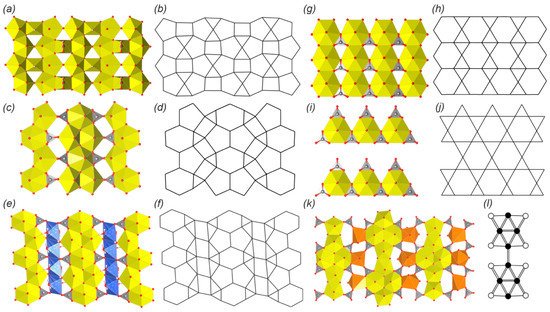
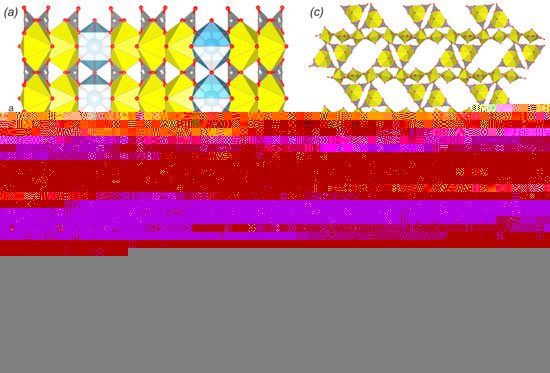
4. Structural and Topological Complexity
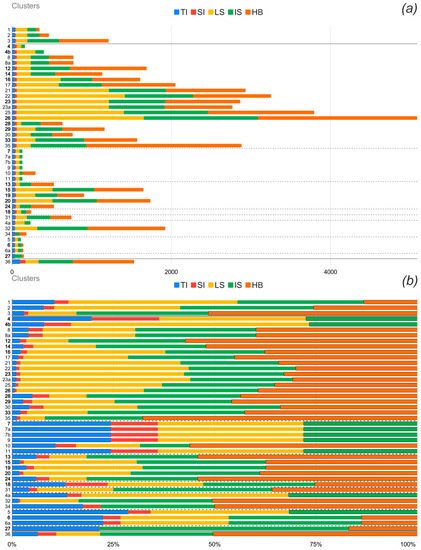
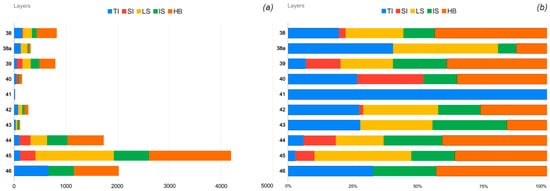
This entry is adapted from the peer-reviewed paper 10.3390/cryst11060704
References
- Alwan, A.K.; Williams, P.A. The aqueous chemistry of uranium minerals. Part 2. Minerals of the liebigite group. Mineral. Mag. 1980, 43, 665–667.
- Clark, D.L.; Hobart, D.E.; Neu, M.P. Actinide carbonate complexes and their importance in actinide environmental chemistry. Chem. Rev. 1995, 95, 25–48.
- Plášil, J. Oxidation–hydration weathering of uraninite: The current state-of-knowledge. J. Geosci. 2014, 59, 99–114.
- Stefaniak, E.A.; Alsecz, A.; Frost, R.; Mathe, Z.; Sajo, I.E.; Torok, S.; Worobiec, A.; Van Grieken, R. Combined SEM/EDX and micro-Raman spectroscopy analysis of uranium minerals from a former uranium mine. J. Hazard Mater. 2009, 168, 416–423.
- Driscoll, R.J.P.; Wolverson, D.; Mitchels, J.M.; Skelton, J.M.; Parker, S.C. A Raman spectroscopic study of uranyl minerals from Cornwall, UK. RSC Adv. 2014, 4, 59137–59149.
- Teterin, Y.A.; Baev, A.S.; Bogatov, S.A. X-ray photoelectron study of samples containing reactor fuel from “lava” and products growing on it which formed at Chernobyl NPP due to the accident. J. Electron Spectrosc. Relat. Phenom. 1994, 68, 685–694.
- Burakov, B.E.; Strykanova, E.E.; Anderson, E. Secondary uranium minerals on the surface of Chernobyl “Lava”. Mat. Res. Soc. Symp. Proc. 1996, 465, 1309–1311.
- Lussier, A.J.; Lopez, R.A.K.; Burns, P.C. A revised and expanded structure hierarchy of natural and synthetic hexavalent uranium compounds. Can. Mineral. 2016, 54, 177–283.
- Gurzhiy, V.V.; Plášil, J. Structural complexity of natural uranyl sulfates. Acta Crystallogr. 2019, B75, 39–48.
- Gurzhiy, V.V.; Kuporev, I.V.; Kovrugin, V.M.; Murashko, M.N.; Kasatkin, A.V.; Plášil, J. Crystal chemistry and structural complexity of natural and synthetic uranyl selenites. Crystals 2019, 9, 639.
- Krivovichev, S.V.; Burns, P.C. Actinide compounds containing hexavalent cations of the VI group elements (S, Se, Mo, Cr, W). In Structural Chemistry of Inorganic Actinide Compounds; Krivovichev, S.V., Burns, P.C., Tananaev, I.G., Eds.; Elsevier: Amsterdam, The Netherland, 2007; pp. 95–182.
- Douglass, M. Tetrasodium uranyl tricarbonate, Na4UO2(CO3)3. Anal. Chem. 1956, 28, 1635.
- Christ, C.L.; Clark, J.R.; Evans, H.T., Jr. Crystal structure of rutherfordine, UO2CO3. Science 1955, 121, 472–473.
- Goff, G.S.; Brodnax, L.F.; Cisneros, M.R.; Peper, S.M.; Field, S.E.; Scott, B.L.; Runde, W.H. First identification and thermodynamic characterization of the ternary U(VI) species, UO2(O2)(CO3)2(4-), in UO2-H2O2-K2CO3 solutions. Inorg. Chem. 2008, 47, 1984–1990.
- Zehnder, R.; Peper, S.; Brian, L.; Runde, S.; Runde, W. Tetrapotassium dicarbonatodioxoperoxouranium(VI) 2.5-hydrate, K4[U(CO3)2O2(O2)]·2.5H2O. Acta Crystallogr. 2005, C61, 3–5.
- Císařová, I.; Skála, R.; Ondruš, P.; Drábek, M. Trigonal Na4[UO2(CO3)3]. Acta Crystallogr. 2001, E37, 32–34.
- Han, J.-C.; Rong, S.-B.; Chen, Q.-M.; Wu, X.-R. The determination of the crystal structure of tetrapotassium uranyl tricarbonate by powder X-ray diffraction method. Chin. J. Chem. 1990, 4, 313–318.
- Chernorukov, N.G.; Mikhailov, Y.N.; Knyazev, A.V.; Kanishcheva, A.S.; Zamkovaya, E.V. Synthesis and crystal structure of rubidium uranyltricarbonate. Russ. J. Coord. Chem. 2005, 31, 364–367.
- Mereiter, K. Structure of Thallium Tricarbonatodioxouranat (VI). Acta Crystallogr. Cryst. Struct. Commun. 1986, C42, 1682–1684.
- Allen, P.G.; Bucher, J.J.; Clark, D.L.; Edelstein, N.M.; Ekberg, S.A.; Gohdes, J.W.; Hudson, E.A.; Kaltsoyannis, N.; Lukens, W.W.; Neu, M.P.; et al. Multinuclear NMR, Raman, EXAFS, and X ray diffraction studies of uranyl carbonate complexes in near-neutral aqueous solution. X-ray structure of (C(NH2)3)6((UO2)3(CO3)6)·6.5(H2O). Inorg. Chem. 1995, 34, 4797–4807.
- Anderson, A.; Chieh, C.; Irish, D.E.; Tong, J.P.K. An X-Ray crystallographic, Raman, and infrared spectral study of crystalline potassium uranyl carbonate, K4UO2(CO3)3. Can. J. Chem. 1980, 58, 1651–1658.
- Li, Y.; Krivovichev, S.V.; Burns, P.C. The crystal structure of Na4(UO2)(CO3)3 and its relationship to schröckingerite. Mineral. Mag. 2001, 65, 297–304.
- Kubatko, K.-A.; Helean, K.B.; Navrotsky, A.; Burns, P.C. Thermodynamics of uranyl minerals: Enthalpies of formation of rutherfordine, UO2CO3, andersonite, Na2CaUO2(CO3)3(H2O)5, and grimselite, K3NaUO2(CO3)3H2O. Amer. Mineral. 2005, 90, 1284–1290.
- Mikhailov, Y.N.; Lobanova, G.M.; Shchelokov, R.N. X-ray structural study of the guanidinium uranyl-peroxo-dicarbonate hydrate (CN3H6)4UO2O2(CO3)2·H2O. Zh. Neorg. Khim. 1981, 26, 718–722.
- Shuvalov, R.R.; Burns, P.C. A monoclinic polymorph of uranyl dinitrate trihydrate, [UO2(NO3)2(H2O)2]·H2O. Acta Crystallogr. 2003, C59, 71–73.
- Thuéry, P. Uranyl Ion Complexes with Cucurbit[n]urils (n = 6, 7, and 8): A new family of uranyl-organic frameworks. Cryst. Growth Des. 2008, 8, 4132–4143.
- Gurzhiy, V.V.; Kornyakov, I.V.; Tyumentseva, O.S. Uranyl nitrates: Byproducts of the synthetic experiments or key indicators of the reaction progress? Crystals 2020, 10, 1122.
- Plášil, J.; Fejfarová, K.; Dušek, M.; Škoda, R.; Rohlíček, J. Actinides in Geology, Energy, and the Environment. Revision of the symmetry and the crystal structure of čejkaite, Na4(UO2)(CO3)3. Am. Mineral. 2013, 98, 549–553.
- Ondruš, P.; Skála, R.; Veselovský, F.; Sejkora, J.; Vitti, C. Čejkaite, the triclinic polymorph of Na4(UO2)(CO3)3—A new mineral from Jachymov, Czech Republic. Am. Min. 2003, 88, 686–693.
- Mazzi, F.; Rinaldi, F. La struttura cristallina del K3Na(UO2)(CO3)3. Period. Mineral. 1961, 30, 1–21.
- Walenta, K. Widenmannit und Joliotit, zwei neue Uranylkarbonatmineralien aus dem Schwarzwald. Schweiz. Mineral. Petrogr. Mitt. 1976, 56, 167–185.
- Li, Y.; Burns, P. The crystal structure of synthetic grimselite, K3Na[(UO2)(CO3)3](H2O). Can. Mineral. 2001, 39, 1147–1151.
- Plášil, J.; Fejfarová, K.; Skála, R.; Škoda, R.; Meisser, N.; Hloušek, J.; Císařová, I.; Dušek, M.; Veselovský, F.; Čejka, J.; et al. The crystal chemistry of the uranyl carbonate mineral grimselite, (K,Na)3Na[(UO2)(CO3)3](H2O), from Jáchymov, Czech Republic. Mineral. Mag. 2012, 76, 443–453.
- Kubatko, K.A.; Burns, P.C. The Rb analogue of grimselite, Rb6Na2((UO2)(CO3)3)2 (H2O). Acta Crystallogr. Cryst. Struct. Commun. 2004, C60, 25–26.
- Skála, R.; Ondruš, P.; Veselovský, F.; Císařová, I.; Hloušek, J. Agricolaite, a new mineral of uranium from Jáchymov, Czech Republic. Mineral. Petrol. 2011, 103, 169–175.
- Charushnikova, I.A.; Fedoseev, A.M.; Perminov, V.P. Synthesis and Crystal Structure of Cesium Actinide(VI) Tricarbonate Complexes Cs4AnO2(CO3)3·6H2O, An(VI) = U., Np, Pu. Radiochemistry 2016, 58, 578–585.
- Mereiter, K. Structure of cesium tricarbonatodioxouranate(VI) hexahydrate. Acta Crystallogr. Cryst. Struct. Commun. 1988, C44, 1175–1178.
- Krivovichev, S.V.; Burns, P.C. Synthesis and crystal structure of Cs4(UO2(CO3)3). Radiochemistry 2004, 46, 12–15.
- Serezhkin, V.N.; Soldatkina, M.A.; Boiko, N.V. Refinement of the crystal-structure of (NH4)4UO2(CO3)3. J. Struct. Chem. 1983, 24, 770–774.
- Axelrod, J.M.; Grimaldi, F.S.; Milton, C.; Murata, K.J. The uranium minerals from the Hillside mine, Yavapai County, Arizona. Am. Mineral. 1951, 36, 1–22.
- Mayer, H.; Mereiter, K. Synthetic bayleyite, Mg2[UO2(CO3)3]·18H2O: Thermochemistry, crystallography and crystal structure. Tschermaks Mineral. Petrogr. Mitt. 1986, 35, 133–146.
- Mereiter, K. Synthetic swartzite, CaMg[UO2(CO3)3]·12H2O, and its strontium analogue, SrMg[UO2(CO3)3]·12H2O: Crystallography and crystal structures. Neues Jahrb. Mineral. Mon. 1986, 1986, 481–492.
- Amayri, S.; Arnold, T.; Foerstendorf, H.; Geipel, G.; Bernhard, G. Spectroscopic characterization of synthetic becquerelite, Ca[UO2)6O4(OH)6]·8H2O, and swartzite, CaMg[UO2(CO3)3]·12H2O. Can. Mineral. 2004, 42, 953–962.
- Vochten, R.; Van Haverbeke, L.; Van Springel, K. Synthesis of liebigite and andersonite, and study of their thermal behavior and luminescence. Can. Mineral. 1993, 31, 167–171.
- Smith, J.L. Two new minerals—medjidite (sulphate of uranium and lime)—Liebigite (carbonate of uranium and lime). Am. J. Sci. Arts 1848, 5, 336–338.
- Mereiter, K. The crystal structure of liebigite, Ca2UO2(CO3)3·~11H2O. Tschermaks Mineral. Petrogr. Mitt. 1982, 30, 277–288.
- Kampf, A.R.; Plášil, J.; Kasatkin, A.V.; Marty, J.; Čejka, J. Markeyite, a new calcium uranyl carbonate mineral from the Markey mine, San Juan County, Utah, USA. Mineral. Mag. 2018, 82, 1089–1100.
- Kampf, A.R.; Olds, T.A.; Plášil, J.; Burns, P.C.; Marty, J. Natromarkeyite and pseudomarkeyite, two new calcium uranyl carbonate minerals from the Markey mine, San Juan County, Utah, USA. Mineral. Mag. 2020, 84, 753–765.
- Mereiter, K. Structure of strontium tricarbonatodioxouranate(VI) octahydrate. Acta Crystallogr. Cryst. Struct. Commun. 1986, C42, 1678–1681.
- Olds, T.; Sadergaski, L.; Plášil, J.; Kampf, A.; Burns, P.; Steele, I.; Marty, J.; Carlson, S.; Mills, O. Leószilárdite, the first Na,Mg-containing uranyl carbonate from the Markey Mine, San Juan County, Utah, USA. Mineral. Mag. 2017, 81, 1039–1050.
- Gurzhiy, V.V.; Krzhizhanovskaya, M.G.; Izatulina, A.R.; Sigmon, G.E.; Krivovichev, S.V.; Burns, P.C. Structure refinement and thermal stability studies of the uranyl carbonate mineral Andersonite, Na2Ca[(UO2)(CO3)3]·(5+x)H2O. Minerals 2018, 8, 586.
- Coda, A.; Della Giusta, A.; Tazzoli, V. The structure of synthetic andersonite, Na2Ca[UO2(CO3)3].xH2O (x = 5.6). Acta Cryst. 1981, B37, 1496–1500.
- Mereiter, K. Neue kristallographische Daten ueber das Uranmineral Andersonit. Anz. Österr. Akad. Wiss. Mathemat. Naturwiss. Kl. 1986, 123, 39–41.
- Plášil, J.; Čejka, J. A note on the molecular water content in uranyl carbonate mineral andersonite. J. Geosci. 2015, 60, 181–187.
- Coda, A. Ricerche sulla struttura cristallina dell’Andersonite. Atti Accad. Naz. Lincei Rend. Cl. Sci. Fis. Mat. Nat. Ser. 1963, 34, 299–304.
- Čejka, J.; Urbanec, Z.; Čejka, J., Jr. To the crystal chemistry of andersonite. Neu. Jb. Mineral. Mh. 1987, 11, 488–501.
- De Neufville, J.P.; Kasdan, A.; Chimenti, R.J.L. Selective detection of uranium by laser-induced fluorescence: A potential remote-sensing technique. 1: Optical characteristics of uranyl geologic targets. Appl. Opt. 1981, 20, 1279–1296.
- Amayri, S.; Arnold, T.; Reich, T.; Foerstendorf, H.; Geipel, G.; Bernhard, G.; Massanek, A. Spectroscopic characterization of the uranium carbonate andersonite Na2Ca[UO2(CO3)3]·6H2O. Environ. Sci. Technol. 2004, 38, 6032–6036.
- Frost, R.L.; Carmody, O.; Ertickson, K.L.; Weier, M.L.; Čejka, J. Molecular structure of the uranyl mineral andersonite—A Raman spectroscopic study. J. Molec. Struct. 2004, 703, 47–54.
- Čejka, J. To the chemistry of andersonite and thermal composition of dioxo-tricarbonatouranates. Coll. Czech. Chem. Commun. 1969, 34, 1635–1656.
- Čejka, J.; Urbanec, Z. Thermal and infrared spectrum analyses of natural and synthetic andersonites. J. Therm. Anal. 1988, 33, 389–394.
- Vochten, R.; van Haverbeke, L.; van Springel, K.; Blaton, N.; Peeters, M. The structure and physicochemical characteristics of a synthetic phase compositionally intermediate between liebigite and andersonite. Can. Mineral. 1994, 32, 553–561.
- Plášil, J.; Mereiter, K.; Kampf, A.R.; Hloušek, J.; Škoda, R.; Čejka, J.; Němec, I.; Ederová, J. Braunerite IMA 2015-123. CNMNC Newsletter No. 31. Mineral. Mag. 2016, 80, 692.
- Plášil, J.; Čejka, J.; Sejkora, J.; Hloušek, J.; Škoda, R.; Novák, M.; Dušek, M.; Císařová, I.; Němec, I.; Ederová, J. Línekite, K2Ca3[(UO2)(CO3)3]2.8H2O, a new uranyl carbonate mineral from Jáchymov, Czech Republic. J. Geosci. 2017, 62, 201–213.
- Kubatko, K.-A.; Burns, P. The crystal structure of a novel uranyl tricarbonate, K2Ca3[(UO2)(CO3)3)]2(H2O)6. Can. Mineral. 2004, 42, 997–1003.
- Effenberger, H.; Mereiter, K. Structure of a cubic sodium strontium magnesium tricarbonatodioxouranate(VI) hydrate. Acta Crystallogr. Cryst. Struct. Commun. 1988, C44, 1172–1175.
- Olds, T.; Plášil, J.; Kampf, A.; Dal Bo, F.; Burns, P. Paddlewheelite, a New Uranyl Carbonate from the Jáchymov District, Bohemia, Czech Republic. Minerals 2018, 8, 511.
- Plášil, J.; Hloušek, J.; Kasatkin, A.V.; Belakovskiy, D.I.; Čejka, J.; Chernyshov, D. Ježekite, Na8[(UO2)(CO3)3](SO4)2·3H2O, a new uranyl mineral from Jáchymov, Czech Republic. J. Geosci. 2015, 60, 259–267.
- Schrauf, A. Schröckingerit, ein neues Mineral von Joachimsthal. Tschermaks Mineral. Petrogr. Mitt. 1873, 1, 137–138.
- Jaffe, H.W.; Sherwood, A.M.; Peterson, M.J. New data on schroeckingerite. Am. Mineral. 1948, 33, 152–157.
- Smith, D.K. An X-ray crystallographic study of schroeckingerite and its dehydration product. Am. Mineral. 1959, 44, 1020–1025.
- Mereiter, K. Crystal structure and crystallographic properties of a schröckingerite from Joachimsthal. Tschermaks Mineral. Petrogr. Mitt. 1986, 35, 1–18.
- Mereiter, K. The crystal structure of albrechtschraufite, MgCa4F2[(UO2)(CO3)3]2·17H2O. Acta Crystallogr. 1984, A40, 247.
- Mereiter, K. Description and crystal structure of albrechtschaufite, MgCa4F2[UO2(CO3)3]2·17-18H2O. Mineral. Petrol. 2013, 107, 179–188.
- Li, Y.; Burns, P.C. New structural arrangements in three ca uranyl carbonate compounds with multiple anionic species. J. Solid State Chem. 2002, 166, 219–228.
- Plášil, J.; Škoda, R. Crystal structure of the (REE)–uranyl carbonate mineral shabaite-(Nd). J. Geosci. 2017, 62, 97–105.
- Deliens, M.; Piret, P. La shabaïte-(Nd), Ca(TR)2(U02)(C03)4(OH)2.6H20, nouvelle espéce minérale de Kamoto, Shaba, Zaïre. Eur. J. Mineral. 1989, 1, 85–88.
- Fedosseev, A.M.; Gogolev, A.V.; Charushnikova, I.A.; Shilov, V.P. Tricarbonate complex of hexavalent Am with guanidinium: Synthesis and structural characterization of [C(NH2)3]4[AmO2(CO3)3]·2H2O, comparison with [C(NH2)3]4[AnO2(CO3)3] (An=U, Np, Pu). Radiochim. Acta 2011, 99, 679–686.
- Reed, W.A.; Oliver, A.G.; Rao, L. Tetrakis(tetramethylammonium) tricarbonatodioxidouranate octahydrate. Acta Crystallogr. 2011, 67, 301–303.
- Olds, T.; Plášil, J.; Kampf, A.; Simonetti, A.; Sadergaski, L.; Chen, Y.-S.; Burns, P. Ewingite: Earth’s most complex mineral. Geology 2017, 45, 1007–1010.
- Guillemin, C.; Protas, J. Ianthinite et wyartite. Bull. Société Française Minéralogie Cristallogr. 1959, 82, 80–86.
- Burns, P.C.; Finch, R.J. Wyartite: Crystallographic evidence for the first pentavalent-uranium mineral. Am. Mineral. 1999, 84, 1456–1460.
- Frost, R.L.; Henry, D.A.; Erickson, K. Raman spectroscopic detection of wyartite in the presence of rabejacite. J. Raman Spectrosc. 2004, 35, 255–260.
- Hawthorne, F.C.; Finch, R.J.; Ewing, R.C. The crystal structure of dehydrated wyartite, Ca(CO3)[U5+(U6+O2)2O4(OH)](H2O)3. Can. Mineral. 2006, 44, 1379–1385.
- Deliens, M.; Piret, P. La fontanite, carbonate hydraté d’uranyle et de calcium, nouvelle espèce minérale de Rabejac, Hérault, France. Eur. J. Mineral. 1992, 4, 1271–1274.
- Hughes, K.A.; Burns, P.C. A new uranyl carbonate sheet in the crystal structure of fontanite, Ca[(UO2)3(CO3)2O2](H2O)6. Am. Mineral. 2003, 88, 962–966.
- Cesbron, F.; Pierrot, R.; Verbeek, T. La roubaultite Cu2(UO2)3(OH)10·5H2O, une nouvelle espèce minérale. Bull. Société Française Minéralogie Cristallogr. 1970, 93, 550–554.
- Ginderow, D.; Cesbron, F. Structure de la roubaultite Cu2(UO2)3(CO3)2O2(OH)2·4H2O. Acta Crystallogr. 1985, 41, 654–657.
- Marckwald, W. Ueber Uranerze aus Deutsch-Ostafrika. Zent. Mineral. Geol. Paläontologie 1906, 1906, 761–763.
- Frondel, C.; Meyrowitz, R. Studies of uranium minerals (XIX): Rutherfordine, diderichite, and clarkeite. Am. Mineral. 1956, 41, 127–133.
- Finch, R.J.; Cooper, M.A.; Hawthorne, F.C.; Ewing, R.C. Refinement of the crystal structure of rutherfordine. Can. Mineral. 1999, 37, 929–938.
- Plášil, J. A unique structure of uranyl-carbonate mineral sharpite: A derivative of the rutherfordine topology. Z. Krist. Cryst. Mater. 2018, 233, 579–586.
- Melón, M.J. La sharpite, nouveau carbonate d’uranyle du Congo belge. Bull. Séances l’Institut R. Colonial Belg. 1938, 9, 333–336.
- Cejka, J.; Mrazek, Z.; Urbanec, Z. New data on sharpite, a calcium uranyl carbonate. Neues Jahrb. Mineral. Monatsh. 1984, 1984, 109–117.
- Elton, N.J.; Hooper, J.J. Widenmannite from Cornwall, England: The second world occurrence. Mineral. Mag. 1995, 59, 745–749.
- Plášil, J.; Čejka, J.; Sejkora, J.; Škácha, P.; Goliáš, V.; Jarka, P.; Laufek, F.; Jehlička, J.; Němec, I.; Strnad, L. Widenmannite, a rare uranyl lead carbonate: Occurrence, formation and characterization. Miner. Mag. 2010, 74, 97–110.
- Plášil, J.; Palatinus, L.; Rohlíček, J.; Houdková, L.; Klementová, M.; Goliáš, V.; Škácha, P. Crystal structure of lead uranyl carbonate mineral widenmannite: Precession electron-diffraction and synchrotron powder-diffraction study. Am. Mineral. 2014, 99, 276–282.
- Deliens, M.; Piret, P. La kamototïte-(Y), un nouveau carbonate d’uranyle et de terres rares de Kamoto, Shaba, Zaïre. Bull. Minéralogie 1986, 109, 643–647.
- Plášil, J.; Petříček, V. Crystal structure of the (REE)-uranyl carbonate mineral kamotoite-(Y). Mineral. Mag. 2017, 81, 653–660.
- Deliens, M.; Piret, P. Bijvoetite et lepersonnite, carbonates hydrates d’uranyle et de terres rares de Shinkolobwe, Zaire. Can. Mineral. 1982, 22, 231–238.
- Li, Y.; Burns, P.C.; Gault, R.A. A new rare-earth element uranyl carbonate sheet in the structure of bijvoetite-(Y). Can. Mineral. 2000, 38, 153–162.
- Kampf, A.R.; Plášil, J.; Olds, T.A.; Nash, B.P.; Marty, J.; Belkin, H.E. Meyrowitzite, Ca(UO2)(CO3)2·5H2O, a new mineral with a novel uranyl-carbonate sheet. Am. Mineral. 2019, 104, 603–610.
- Deliens, M.; Piret, P. L’astrocyanite-(Ce), Cu2(TR)2(UO2)(CO3)5(OH)2·1,5 H2O, nouvelle espèce minérale de Kamoto, Shaba, Zaïre. Eur. J. Mineral. 1990, 2, 407–411.
- Vochten, R.; Deliens, M. Blatonite, UO2CO3·H2O, A new uranyl carbonate monohydrate from San Juan County, Utah. Can. Mineral. 1998, 36, 1077–1081.
- Coleman, R.G.; Ross, D.R.; Meyrowitz, R. Zellerite and metazellerite, new uranyl carbonates. Am. Mineral. 1966, 51, 1567–1578.
- Vochten, R.; Deliens, M.; Medenbach, O. Oswaldpeetersite, (UO2)2CO3(OH)2·4H2O, a new basic uranyl carbonate mineral from the Jomac uranium mine, San Juan County, Utah, U.S.A. Can. Mineral. 2001, 39, 1685–1689.
- Thompson, M.E.; Weeks, A.D.; Sherwood, A.M. Rabbittite, a new uranyl carbonate from Utah. Am. Mineral. 1955, 40, 201–206.
- Deliens, M.; Piret, P. L’urancalcarite, Ca(UO2)3CO3(OH)6.3H2O, nouveau minéral de Shinkolobwe, Shaba, Zaïre. Bull. Minéralogie 1984, 107, 21–24.
- Vogl, J.F. Drei neue Mineral-Vorkommen von Joachimsthal. Jahrb. Kais. Königlichen Geol. Reichsanst. 1853, 4, 220–223.
- Piret, P.; Deliens, M. New crystal data for Ca, Cu, UO2 hydrated carbonate: Voglite. J. Appl. Crystallogr. 1979, 12, 616.
- Frost, R.L.; Dickfos, M.J.; Cejka, J. Raman spectroscopic study of the uranyl carbonate mineral zellerite. J. Raman Spectrosc. 2008, 39, 582–586.
- Chiappero, P.J.; Sarp, H. Nouvelles données sur la znucalite et seconde occurrence: Le Mas d’Alary, Lodève (Hérault, France). Arch. Sci. 1993, 46, 291–301.
- Ondruš, P.; Veselovský, F.; Rybka, R. Znucalite, Zn12(UO2)Ca(CO3)3(OH)22·4H2O, a new mineral from Príbram, Czechoslovakia. Neues Jahrb. Mineral. Mon. 1990, 1990, 393–400.
- Demartin, F.; Diella, V.; Donzelli, S.; Gramaccioli, C.M.; Pilati, T. The importance of accurate crystal structure determination of uranium minerals. I. Phosphuranylite KCa(H3O)3(UO2)7(PO4)4O4·8H2O. Acta Crystallogr. 1991, B47, 439–446.
- Kepler, J. Harmonices Mundi Libri V; Forni: Bologna, Italy, 1619.
- Blatov, V.A.; Shevchenko, A.P.; Proserpio, D.M. Applied topological analysis of crystal structures with the program package ToposPro. Cryst. Growth. Des. 2014, 14, 3576–3586.
